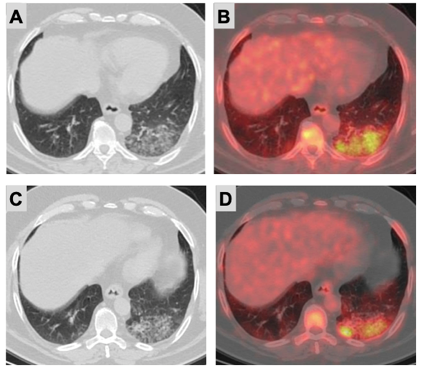
Imaging techniques and COVID19 diagnosis
During the COVID-19 pandemic, computed tomography (CT) is the imaging method of choice to diagnose and monitor patients with COVID-19 because of its resolution, availability in intensive care units, and cost-effectiveness. Scientists from the University Federico II of Naples, part of Euro-BioImaging’s Molecular Imaging Italian Node, decided to evaluate the use of medical imaging technologies such as FDG-PET/CT during the COVID-19 pandemic in Southern Italy. They undertook a comparative study, analysing images gathered from February to April 2020 and the corresponding period of 2019, to assess the impact of the pandemic on FDG-PET/CT workflow and evaluate the occurrence of abnormal imaging findings for interstitial pneumonia by COVID-19 infection in Southern Italy. Their findings have been submitted to the European Journal of Nuclear Medicine and Molecular Imaging. Contributing author, Professor Alberto Cuocolo, Node member and Italian delegate on the Euro-BioImaging Board, discusses the results and explains why FDG-PET/CT imaging is important to COVID-19 diagnosis.
The COVID-19 pandemic and resulting lockdown had an impact on work flows in laboratories across Europe and the world. In Italy, a group of scientists decided to analyse the use of CT imaging facilities by cancer patients during the lockdown situation as compared with the previous year. The findings indicate that the number of FDG PET/CT studies performed during the pandemic and in the corresponding period of 2019 were comparable.
Then a team of experienced radiologists evaluated the CT scans. The percentage of abnormal FDG-PET/CT findings, suspicious for interstitial pneumonia by Covid-19 infection, was significantly (P = 0.02) higher during the pandemic (9%) compared to that found in the corresponding period of 2019 (4%).
However, no significant differences were observed in the distribution of Covid-19 reporting and data system (CO-RADS) classification and in the maximum standardized uptake value between pandemic and corresponding period of the 2019.
Of note, patients with abnormal imaging findings during the pandemic time had clinical data and/or laboratory tests negative for Covid-19 infection.
Nuclear medicine physicians need specific training when analysing CT scans in COVID-19 diagnosis
In this regard, although CT scan has been shown to be useful in terms of diagnostic sensitivity for Covid-19 infection, its accuracy in differentiating such infection from other viral pneumonia was reported to be limited. Their results confirm these observations suggesting a high diagnostic sensitivity, but a low diagnostic specificity.
Therefore, these data show that incidental FDG-PET/CT findings suggestive of Covid-19 infection may occur and hence it is fundamental that nuclear medicine physicians acquire diagnostic skills to recognize typical findings on the co-registered CT images.
Benefiting from open access to imaging facilities
The imaging work was carried out in collaboration with the Molecular Imaging Italian Node, a multi-sited facility that is part of Euro-BioImaging. All scientists, regardless of affiliation, area of expertise, or field of activity, can benefit from Euro-BioImaging’s pan-European open access services. For most technologies, scientists are invited to receive hands-on training at the imaging instrument of their choice so that they can generate the desired data sets themselves and expand their technological knowledge. New technologies are included continuously to offer access to the most innovative and pioneering technologies on the market.

More news from Euro-BioImaging


